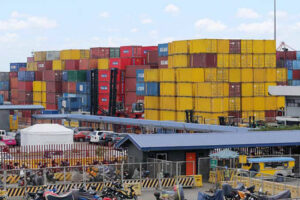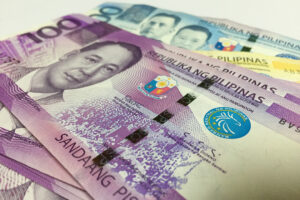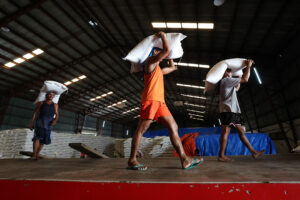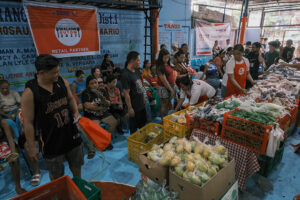By Luisa Maria Jacinta C. Jocson, Senior Reporter
THE PHILIPPINES has room to negotiate with the US to bring down its reciprocal tariff to as low as 10% using defense concessions as a key bargaining chip, according to Fitch Solutions’ research unit BMI.
“While [former US President Donald J.] Trump has raised the rate from 17% to 20% for no explicit reason, the Philippines still faces some of the lowest tariffs in Asia,” Darren Tay, head of Asia country risk at BMI, told a webinar on Thursday.
“Overall, we still think the Philippines stands a good chance of bargaining the reciprocal rate down to the baseline 10%,” he added.
The Philippine government earlier said it is working to secure better terms with the US after Mr. Trump announced a 20% tariff on Philippine goods last week, effective Aug. 1.
“While few details have emerged from bilateral trade talks, we believe defense spending will emerge as a point of contention in the proceedings,” Mr. Tay said.
“Making concessions on defense is one good way of securing a trade deal, given that pushing allies to do more is one of Trump’s priorities,” he added.
He said increasing defense spending to 5% of economic output, similar to North Atlantic Treaty Organization benchmarks, would “impress” Mr. Trump, but noted that the Philippines is likely to propose a lower percentage.
Data from the Stockholm International Peace Research Institute showed the Philippines’ military expenditure rose nearly 20% to $6.12 billion in 2024 from a year earlier. This brought the country’s military burden — military spending as a percentage of gross domestic product (GDP) — to 1.3%.
“But that should still be sufficient to secure a deal. Our base case, therefore, envisions reciprocal tariffs at 10%,” Mr. Tay said.
He noted that even in a worst-case scenario where tariffs rise to 20% across all sectors — including a 200% duty on pharmaceuticals — the overall impact would be limited due to the Philippines’ minimal export volume of such products to the US.
BMI maintained its economic growth outlook for the Philippines, noting that the country is less vulnerable to tariff shocks than its regional peers.
“In terms of GDP at risk, the Philippines is relatively insulated,” Mr. Tay said. “Besides the fact that export exposure to the US is slightly below average, we know that roughly half of exports to the US actually come in the form of services that are largely provided by the business process outsourcing sector — and those are untouched by tariffs.”
BMI projects Philippine GDP to grow 5.4% this year, slightly below the government’s 5.5% to 6.5% target.
INCREASED COSTSMeanwhile, Moody’s Analytics said the US tariff could drive up costs and force businesses to rethink their supply chain strategies.
“The introduction of a 20% blanket tariff on Philippine exports to the United States adds complexity to global supply chains,” Moody’s Senior Director Choon Hong Chua said in a commentary released this week.
He added that the tariff could increase operational uncertainty for Philippine exporters accessing the US market.
“Philippine exporters may face increased costs and heightened uncertainty in accessing the US market, which could lead to reduced demand and intensified competitive pressures — particularly if higher costs are passed on to consumers,” Mr. Chua said.
Mr. Trump announced the tariff, which takes effect on Aug. 1, last week. The 20% rate is higher than the 17% initially announced in April and brings the Philippines in line with tariffs imposed on Vietnam, which recently secured a trade deal with the US, and now also faces a 40% duty on transshipped goods.
Other Southeast Asian nations also hit with increased tariffs include Laos and Myanmar (40%), Cambodia and Thailand (36%), Indonesia (32%), and Malaysia and Brunei (25%).
Moody’s noted that the Philippines could be affected since the US is the top destination for Philippine-made goods. More than 15% of the country’s exports in May were bound for the US, according to the Philippine Statistics Authority.
Mr. Chua advised companies with exposure to Philippine-based sourcing to reconsider their supplier strategies amid rising geopolitical and tariff-related risks.
“For companies with exposure to Philippine sourcing, it may be prudent to reassess supplier strategies in light of evolving geopolitical and tariff-related risks,” he said.
While firms may look to shift their sourcing to other Southeast Asian markets, Mr. Chua warned that such a move could involve short-term operational challenges.
“While some organizations may consider alternative sourcing options within Southeast Asia, any transition could involve short-term operational adjustments,” he said.
Despite these potential disruptions, Mr. Chua cited the importance of keeping a flexible and well-monitored supply chain to weather trade uncertainties.
“Maintaining supply chain visibility and agility remains essential for resilience,” he said. “Businesses that proactively adapt to shifting trade conditions and mitigate emerging risks will be better positioned to navigate ongoing uncertainty.”
Moody’s commentary underscores growing global concerns about how escalating trade measures could reverberate through supply chains, particularly in export-dependent economies like the Philippines.






